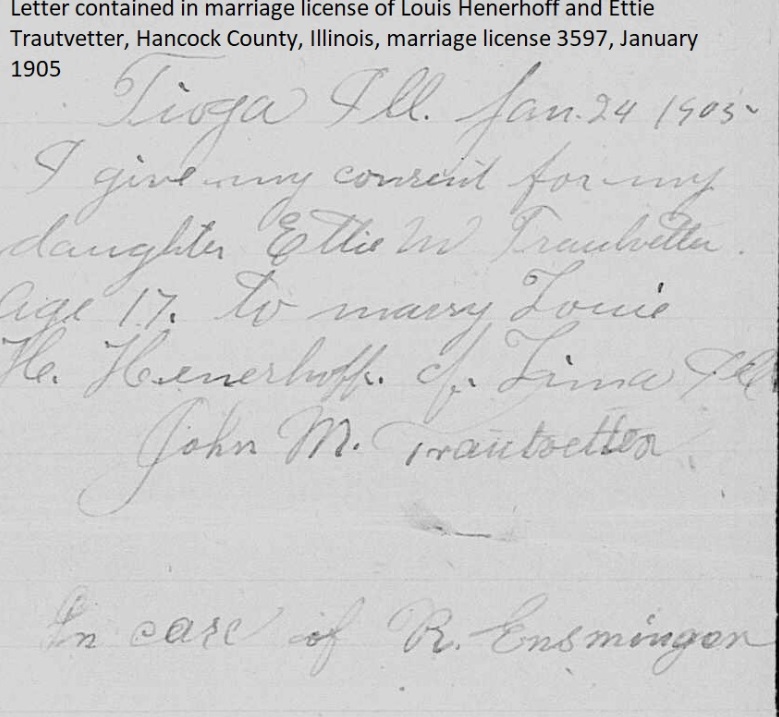
It took me years to locate a signature of John Michael Trautvetter who died in Hancock County, Illinois, in 1917. It was not for lack of trying. It was simply because of the records that he left behind.
John was not one of those ancestors who leaves few records and is hard to document. He appears in numerous records after his family immigrated from Germany in 1853. It was simply that most of those records did not include his actual signature.
John was easily found in every US federal census from 1860 through 1910. Obviously those records do not contain his signature or his handwriting–he was not the census taker on any of those records.
John’s 1868 marriage record in Hancock County, Illinois, does not contain his signature either. The only actual signatures that record contains are from the minister who married them and his in-laws who signed a letter indicating that their daughter could get married. A review of other marriage records for the same time period indicated that John’s marriage was not unique in that aspect. It’s always good to look at other records to see if the one of interest is unusual in any way. John’s was not.
John owned approximately 200 acres of real estate in Hancock County from the 1860s until he died in 1917. The deeds of acquisition for those parcels were not signed by him. While John did mortgage the property on at least two occasions, the record copies of those mortgages in the courthouse are handwritten transcriptions–again typical for the time period. Handwritten transcriptions indicate that the original was signed by John and acknowledged by him, but it’s the clerk’s handwriting on the transcription. Again that’s typical for the time period and location.
John did not write a will and died intestate. While the packet of papers for his probate settlement is fairly large, there’s no original document in the file that contains his signature. That’s not unusual.
John did not serve in the Civil War so there’s no pension application or military materials that would have included a copy of his signature either.
John’s parents deeded their real property to their son before they died. Because of this, there’s no probate record for either of them (I’ve looked). Had there been a probate file for either of his parents, John’s signature may have been contained in a petition, on a receipt, or some other document in the file.
John’s father-in-law died in 1855 before John had married into the family so he would not have been mentioned in that record either.
John’s mother-in-law died in 1904 and this was another possible place where John’s signature might have appeared–perhaps on a receipt, a claim, etc. There was no mention on John in her probate and I was not surprised. John’s wife had been dead for fifteen years by this time. While his children were heirs of the mother-in-law (since they were her grandchildren and their mother was dead), they were all of the age of majority. Had one of them been a minor at the time their grandmother died, John may have been mentioned.
But fortunately, at least in terms of my search for his signature, John’s daughter was under the age of majority when she married in 1905. Because of that, she needed John’s permission to marry. That was where I found the only extant copy of his actual signature: in her marriage record.
Given the time period, the way records were kept, and the way the family’s finances were handled, it was not unusual for John to just about slip through life without leaving a copy of his signature around.
Unfortunately there are no family letters or other materials of that type either.
The next question is: did John write the letter of consent or did he just sign it?


No responses yet